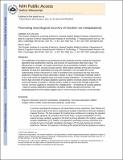Promoting neurological recovery of function via metaplasticity
Author(s)
Cho, Kathleen K.; Bear, Mark
DownloadBear-Promoting neurological recovery.pdf (204.7Kb)
OPEN_ACCESS_POLICY
Open Access Policy
Creative Commons Attribution-Noncommercial-Share Alike
Terms of use
Metadata
Show full item recordAbstract
The modification of synapses by neural activity has been proposed to be the substrate for experience-dependent brain development, learning, and recovery of visual function after brain injury. The effectiveness or ‘strength’ of synaptic transmission can be persistently modified in response to defined patterns of pre- and post-synaptic activity. Well-studied examples of this type of synaptic plasticity are long-term potentiation and long-term depression. Can we exploit the current understanding of these mechanisms in order to strengthen brain connections that may have been weakened or impaired by sensory deprivation, disease or injury? Theoretically motivated research in the visual cortex has suggested ways to promote synaptic potentiation. The theoretical concept is that the type and extent of synaptic plasticity caused by patterns of activity depend critically on the recent prior history of synaptic or cellular activity. Studies in visual cortex strongly support this concept, and have suggested a mechanism for ‘metaplasticity’ – the plasticity of synaptic plasticity – based on activity-dependent modification of NMDA-receptor structure and function. The knowledge gained by these studies suggests ways in which recovery of function can be promoted.
Date issued
2010-01Department
Massachusetts Institute of Technology. Department of Brain and Cognitive Sciences; Picower Institute for Learning and MemoryJournal
Future Neurology
Publisher
Future Medicine Ltd.
Citation
Cho, Kathleen K.A., and Mark F. Bear. “Promoting Neurological Recovery of Function via Metaplasticity.” Future Neurology 5.1 (2010): 21–26.
Version: Author's final manuscript
ISSN
1479-6708
1748-6971